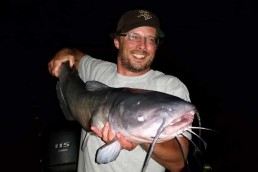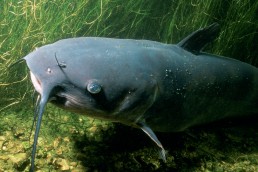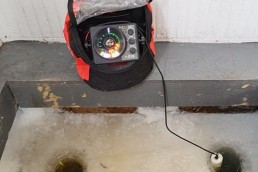Monster Cats
SHARE THIS POST
Want to catch a big fish? No, not just a big fish, a huge fish? The North American record flathead catfish caught on a rod and reel weighed 123 pounds when it was taken from the Elk City Reservoir in Kansas in 1998. The blue catfish, which holds the North American record, weighed 111 pounds when it was taken from the Wheeler Reservoir in Alabama in 1996.
No other record for common freshwater fish even comes close to those two. And, those channel catfish you prize when they are pansized? The North American record weighed 58 pounds when it was caught at Santee Cooper Reservoir in South Carolina in 1964.
Another factor that makes catfish so popular is this—they are accessible. They swim in rivers and lakes in about 40 states and Canada. The Mississippi River is a known haunt of big specimens. The Minnesota River hosts big flatheads, too.
Equipment is simple. Start with at least a seven- to eight-foot rod with plenty of backbone, like one of St. Croix’s muskie rods. Longer rods allow longer casts when fishing from shore.
Add a big spinning reel capable of handling big line. Consider investing in a bait-runner reel. They are spinning reels with a dual-drag system that lets the fish take line without feeling resistance, even when the bail is closed. That lets you keep line tight without fear of losing your outfit. The Europeans and Asians have been using them to fish for carp for years.
Start with 25-pound-test TUF Line superbraid for channel cats. Step up to 50-pound line when you are looking for big flatheads in the Missouri or Mississippi rivers where rocks can cut line and hooked fish have a habit of darting for the nearest logjam.
For night fishing use bright colored line and a black light, or tape a cyalume stick to the tip of the rod as a strike indicator.
Are you enjoying this post?
You can be among the first to get the latest info on where to go, what to use and how to use it!
Terminal tackle will look familiar to that used by walleye fishermen. A snelled hook combined with a slip sinker is perfect for the heavy cover that sometimes holds catfish. Rig it so the fish feels nothing when it picks up the bait. In calm or really shallow water, try no sinker at all. Let the weight of the bait take it to the bottom.
Keep leaders short and use a strong, 1/0 bait keeper hook for most purposes; a 4/0 or 5/0 hook for the big fish. Your bait will depend on the species of catfish you are targeting.
Catfish expert, Doug Stange, prefers to use bigger, live bait for flatheads due to their larger mouths and finicky preferences. His bait selection would include six- inch bullheads or eight- to 12- inch suckers. Flatheads will also take cut bait occasionally.
Channel cats aren’t quite so particular. They’ll take nightcrawlers or dead/live minnows in spring. Cut bait will work nearly anytime. Or try chicken liver. Shrimp should be fresh, not the iodine-treated frozen kind. Prepared stinkbaits, like cheese bait, work best later in the summer. Downsize your hook to a #6 or #8 treble.
Target rivers early in the year. Fish the willows and fields flooded by spring rains. Nightcrawlers—seven or eight on a hook—are the best bait in high water. As the river drops, move to what normally is the river’s edge. Concentrate on river bends in June and July. Use your sonar to look for holes or cover on the outside turns.
In August and September, anchor on the channel edge. If you can find cover, like a woodpile, all the better. Holes around grain elevators at times when barges are being loaded can yield spectacular results, too. Move to places where culverts and creeks discharge into the river after it rains. In lakes, target points with slip float rigs set just off the bottom. Don’t anchor. Drift slowly over the structure.
Try some catfishing. It will soon have you purring.
MWO
SHARE THIS POST
Did you enjoy this post?
You can be among the first to get the latest info on where to go, what to use and how to use it!
Ted Takasaki
Ted Takasaki is an International Fishing Hall of Fame professional angler who has been featured in many national outdoor magazines and television shows. Takasaki has appeared in front of thousands of angling enthusiasts and is considered one of America’s top walleye and multispecies anglers. Follow him on his Facebook page.



